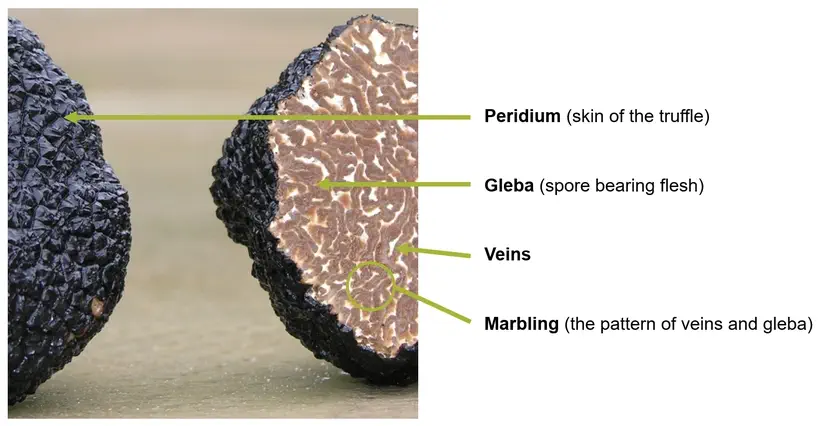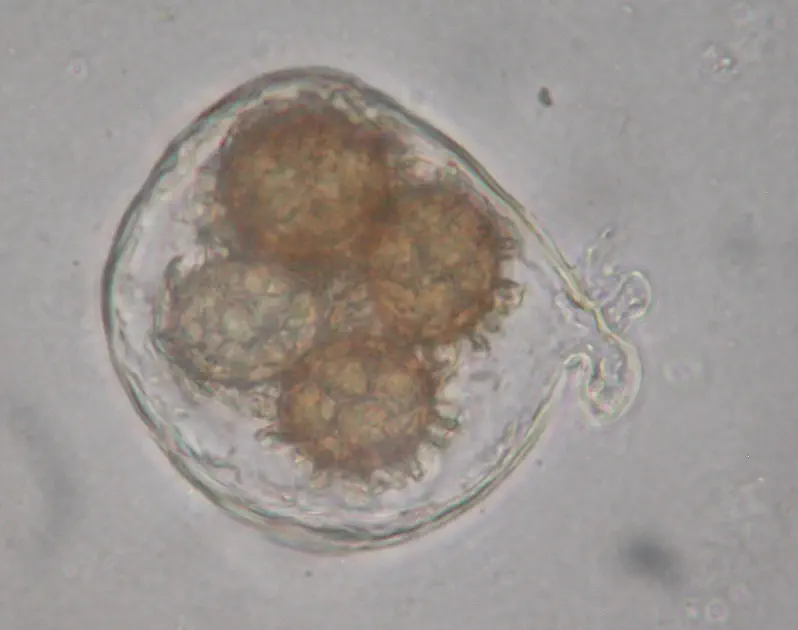Having evolved underground, truffles lack the distinctive features of mushrooms such as coloured caps, with many looking more like potatoes or clods of soil than mushrooms. Determining the species of a truffle requires examination of macroscopic characteristics (visible to the naked eye) and potentially, using a microscope to look at the truffle’s spores. Even with the information and tools it’s not easy! Researcher’s opinions on some species, whether they are the same or different, related or not, can be divided.
Macroscopic Examination
For most of us, determining the species of a truffle is based on morphological characteristics. These are macroscopic in scale (visible to the naked eye) although a hand lens may help with finer detail.
- Shape
- Size
- Colour
- Peridium (truffle skin) presence / absence of warts, wart size / shape, thickness, colour etc.
- Gleba (truffle flesh) colour, marbling, presence / absence of chambers, etc.

Additionally, you consider:
- Aroma and potentially, flavour
- The habitat where the truffle was found. Knowing the species of trees it was growing with and basic knowledge of the soils can further assist.
- For some species, a colour reaction to a chemical such as iodine helps identification.
Microscopic Examination
Getting more accurate identification requires a microscope for examination of the spores, a fair amount of technical expertise, and a lot of practice! Their size, shape, colour and ornaments are among the features examined.

You can contact this user here. 2016-11-10 Tuber uncinatum Chatin 691010, CC BY-SA 3.0
More recently, in the laboratory, molecular (DNA) analyses are used to determine species accurately. Companies that produce truffle trees need to get identifications 100% correct, so they routinely use DNA testing.
Using a Key to Determine the Species of a Truffle
In biology, an identification key, taxonomic key, or biological key is a printed or computer-aided device that aids the identification of biological entities, such as plants, animals, fossils, microorganisms, and pollen grains. If you are not familiar with using one, this video will quickly demonstrate.
The most comprehensive keys for hypogeous fungi in Britain, including those of the Tuber group, are found in the book detailed here. Be warned, they are very complicated for the “lay person”. These were based on the work of Lilian E. Hawker. The below is her key for British species of Tuber. In some cases, it still requires results of a microscopic examination of the spores, though even without it, you may get an identification. Descriptions, pictures and a map of the British distribution of each species can be found with the links in the right-hand column. A glossary for selected terms is below the key.
| 1. | Peridium smooth, scurfy or puberulent, light coloured, yellow, brown or reddish brown, never entirely black | 2 |
| Peridium coarsely verrucose, black, purplish black or brown-black | 10 | |
| 2. | Spores spiny | 3 |
| Spores reticulate | 4 | |
| 3. | Fruit-body smooth, shining, yellow-brown, gleba cream | T. nitidum |
| Fruit-body dull, smooth or scurfy, red-brown | T. rufum | |
| 4. | Fruit-body with conspicuous basal cavity | T. excavatum |
| Fruit-body without conspicuous basal cavity | 5 | |
| 5. | Fruit-body puberulent throughout development | T. puberulum |
| Fruit-body smooth or scurfy or puberulent only when young | 6 | |
| 6. | Fruit-body waxy, lobed, at first white, becoming irregularly stained yellow | T. maculatum |
| Fruit-body firm or soft, not waxy, at first white, soon becoming ochre yellow, reddish or potato-coloured | 7 | |
| 7. | Fruit-body dingy white to ochre, often becoming cracked and blackened, gleba at first cream, finally almost black, veins always yellow-white, numerous, conspicuous, peridium sharply marked off from gleba | T. rapaeodorum |
| Fruit-body reddish or potato-coloured at maturity | 8 | |
| 8. | Fruit-body reddish | T. foetidum |
| Fruit-body potato-coloured or golden brown, not red | 9 | |
| 9. | Fruit-body potato-coloured or golden brown, veins sparsely branched and from base | T. borchii |
| Fruit-body potato to milk chocolate-coloured, veins densely branched and originating from more than one point on periphery | T. dryophilum | |
| 10. | Spores spiny | T. brumale |
| Spores reticulate | 11 | |
| 11. | Spores large, up to 80µ, peridial warts irregular | T. macrosporum |
| Spores never more than 50µ, peridial warts large, regular | T. aestivum |
Glossary
gleba – spore-bearing flesh
lobed – margin has irregular, large, blunt, blobby extensions
peridium – skin of the truffle
puberulent – having fine, short, usually erect, hairs
reticulate – marked with a net-like pattern
scurfy – finely scaly
verrucose – covered with small rounded warts
Identification Challenges
If you are struggling to determine the species of a truffle you have found, it can be difficult:
- “All species of Tuber show considerable changes in shape, colour and other characters during development. Variation within the species, due partly to differences in environmental factors, is often considerable.” Lilian E. Hawker (1954), British Hypogeous Fungi, Trans. Roy. Soc., London, Sr B, 237: 429-546
- You may get one species growing in amongst another.
- Scientific (Latin) names change – new studies, including genetic ones, may decide that what were previously distinct species are the same. Authors of different studies may not agree on their findings!
- The literature on this topic is quite technical and sometimes conflicting!
- Not all information may be up to date.
- You will find synonyms – scientific names that applied to a species that (now) goes by a different scientific name.
- Common (English) names can confuse!
- Some truffle species have multiple common names. For example, the Périgord truffle (Tuber melansporum) is also known as the black winter truffle or just simply, the black truffle.
- Some common names are used to refer to more than one species! For example, winter truffle is used for T. melansporum and T. brumale.
